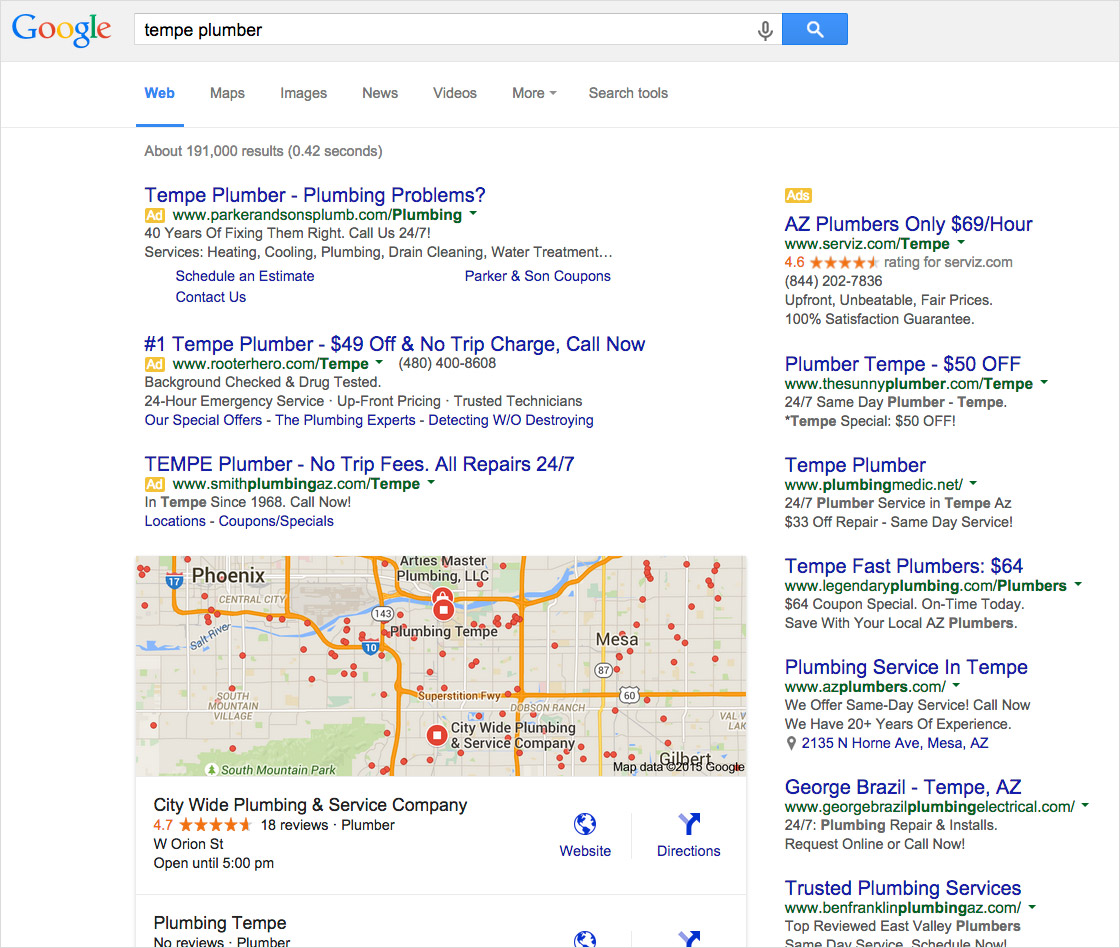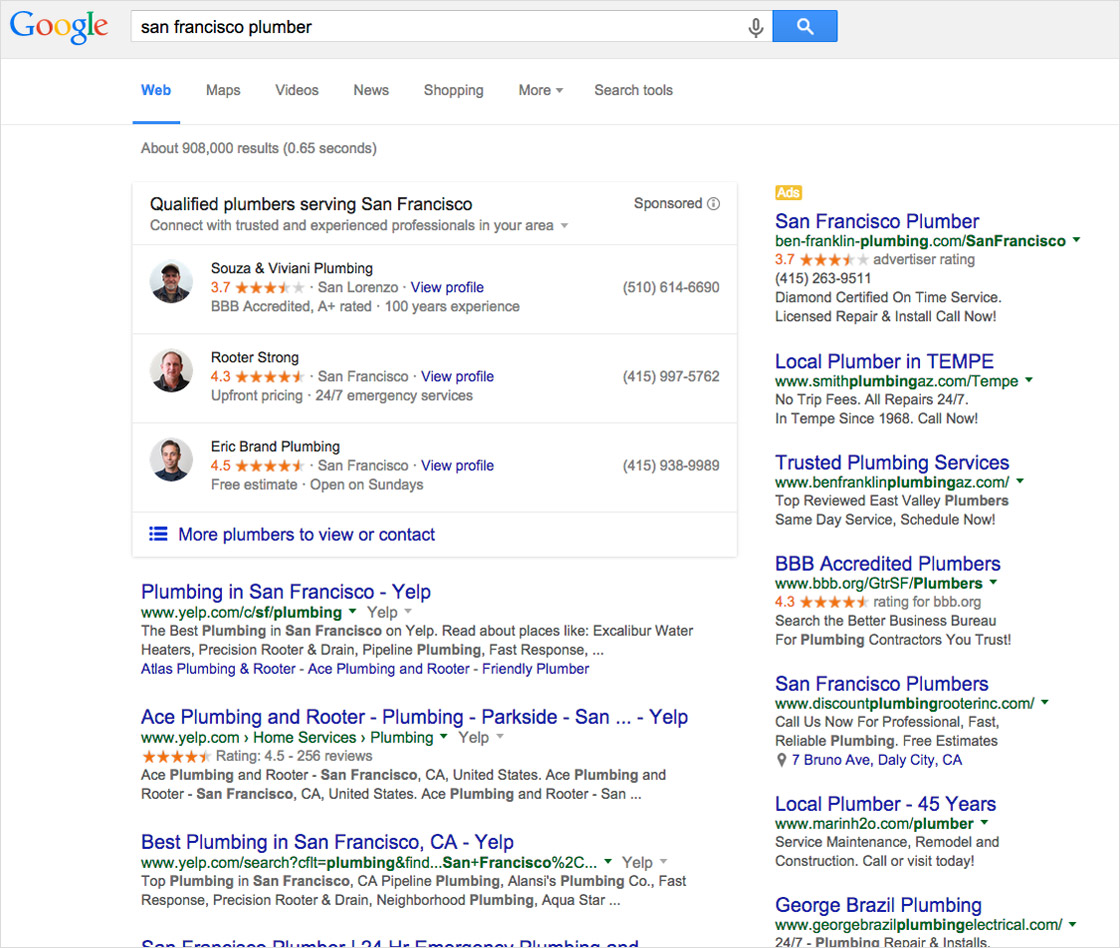Home service professionals are businesses that come to your home to provide a service. Plumbers, electricians, locksmiths, cleaning services and handymen are all examples of home service professionals.
They have a unique set of characteristics.
They’re location sensitive because they come to your home. A plumber only advertises in the areas he’s willing to travel. If you think about how you find a plumber, there’s a good chance you might search for “tempe plumbers” or “plumbers in tempe.”
They’re service based and their professionalism is incredibly important. When they do work for you, half of the experience is the actual work and the other half is their timeliness, friendliness and attitude when they’re at your home.
These characteristics are leading Google to create a unique customer experience for people needing their services.
As usual, let’s use an example.
I need a plumber.
Bad news. My toilet broke. Let’s search for a plumber in Tempe.
The screenshot was taken on a 27″ monitor at full height.
There’s a lot going on in the results.
1. Top 3 Google Ads
The top 3 ads are Google AdWords ads. You can see that they’re using sitelinks, phone and callout extensions which are resulting in those ads covering about 50% of the results page.
2. Sidebar Google Ads
The right sidebar is covered with ads which is normal in a competitive space.
3. Location Map
The location map covers about another 30% of the main results section. Unfortunately, it’s only useful to the extent that I can see there are a lot of plumbers in the Tempe area. Shocking.
4. First service provider
The final 20% of the main search area shows one result from the Google map results. This is the only “organic” listing on the entire page.
Google is changing results for home service professionals
When you see the results page for plumbers, it’s fairly obvious that the top three results are paid advertisements. Each listing has a small “ad” icon next to it and the map visually separates them from the organic results.
This layout might be changing.
Google is experimenting with making home service professional ads appear more organic and personalized. They’re also emphasizing Google+ reviews in a space that Yelp has traditionally been the first review site.
This screenshot looks quite a bit different than the first.
The most notable differences are the personalized headshot, integrated reviews and quick access to a phone number.
You can also see that Google removed the “ad” icon next to each listing and included a more subtle “Sponsored” icon in the upper right. Even though the results look organic, they’re paid advertisements and you can only be included if you’re approved by Google and paying for ads.
The integrated reviews are coming from each company’s Google+ profile. If you’re only focused on Yelp reviews and aren’t actively building your Google+ review profile, you should start soon. They’ll immediately become relevant if you want to start advertising as a local home professional.
Subtle Ads & Reviews
Google is making their ads more subtle and Google+ reviews are going to be front and center.
BrightLocal’s annual Customer Review Survey reveals that star rating is the #1 factor used to judge a business and only 13% of businesses consider using a business with a one or two star rating.
If you’re considering running AdWords advertising, pay attention to your Google+ reviews to show visitors a positive representation of your business right away.
Related Posts
- What Is The Difference Between PPC and SEM?
- PC Audit Handbook: How to Analyze Your PPC Campaigns
- The Best PPC Tools of 2022, As Told by PPC Experts
- Beginner’s Guide to UTM Tags & Tracking
- Generate Leads with Facebook Lead Ads
- Cost-per-click vs. cost-per-acquisition: Are you tracking the right PPC metrics?
- How Does Pay Per Click Work?
- Benefits of PPC
- Why Should I Invest in PPC?
- What is Google PPC Advertising?
- Facebook Retargeting Strategy
- Introduction to ManyChat
- Case Study: Return on Ad Spend Optimization
- 🎁🎄 Holiday Ad Spend Strategy
- Should You Be Running Branded Ads?
- SEO vs SEM
- CTAs for YouTube Ads
- Case Study: 258% Increase in Conversions
- Traffic Campaign Strategy
- No Captions on Facebook Ads or YouTube? You’re Killing Performance
- LinkedIn InMail Website Re-targeting






